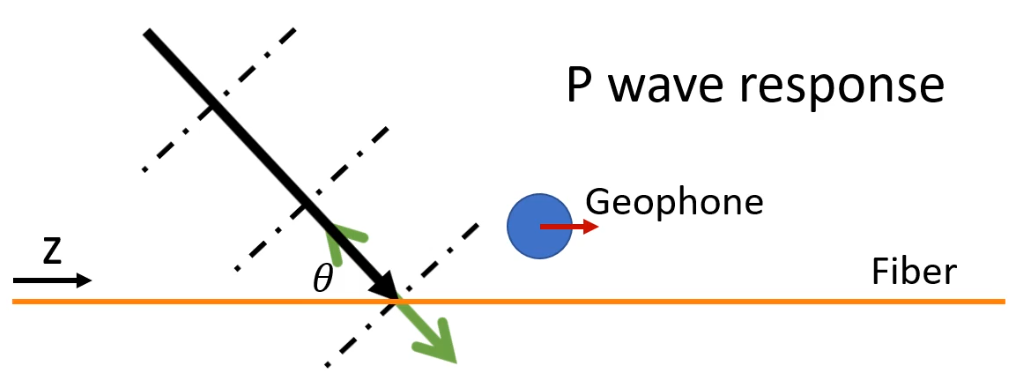Introduction to seismic wave
P wave and S wave.
- DAS as a strain rate sensor
- seismic wave length is much larger than gauge length
- gauge length effect can be ignored
Receiver frequency responses
Velocity Spectrum: \(\dot u=A(\omega)e^{i(\omega t-kx)}\) Acceleration Spectrum: \(\ddot{u}=-i\omega\dot u\)
Wave response
P wave response
We know particle velocity: \(\dot u(z,t)=V_P(z, t) = Ae^{i(\omega t-kz)}\)
Strain: \(\dot\varepsilon(z,t) = \frac{d\dot u}{dz}=-A\cdot ik\cdot e^{i(\omega t-kz)}\)

There will ba an angle in most situation:
Geophone:
\[\dot\varepsilon(z,t) = \frac{d\dot u}{dz}=-\vec A\cdot\hat{\vec z} ik\cdot e^{i(\omega t-kx)}=A\sin\theta e^{i(\omega t-kx)}\]DAS: \(\dot\varepsilon(z,t) = \frac{d\dot u}{dz}=-\frac{1}{2}iAk\cdot\sin 2\theta\cdot e^{i(\omega t-kx)}\)
Note that \(\hat z\) is const while getting the derivative.
- No polarity will be observed in P wave in DAS data.
- Polarity will be observed in S wave in DAS data.
Situation: Gauge length effect
\[\mathrm{DAS\ Channel\approx Geophone2(t)-Geophone1(t)}\]DAS response to P wave
\(\mathrm{DAS(t)}=A(-1+e^{ikL_G})e^{i(-\omega t+\Phi_0)}\)
DAS amplitude: \(A_{DAS}^2=2A^2(1-\cos(kL_G))\)
while \(k=\frac{2\pi}\lambda\).
Thus if \(L_G=\lambda, A_{DAS}=0\).
\(L_G\): Gauge length; k is wave number.
Apparent wave length
\[A_{DAS}^2=2A^2(1-\cos(k_{app}L_G))\]while \(k_{app}=\frac{2\pi}{\lambda_{app}}\). And
\[\lambda_{app}=\frac{\lambda}{\cos\theta}\]Connection between two situations
If \(kL_G\ll1\), we have:
\[\cos(kL_G)\approx1-\frac{k^2L_G^2}{2}\]Then,
\[A_{DAS}=AkL_G\]So it’s still linear.
文档信息
- 本文作者:Shenyao Jin
- 本文链接:https://shenyaojin.github.io/2022/07/14/seismic-wave-das/
- 版权声明:自由转载-非商用-非衍生-保持署名(创意共享3.0许可证)